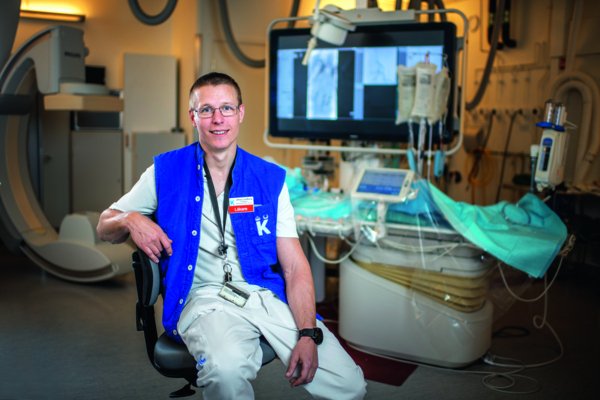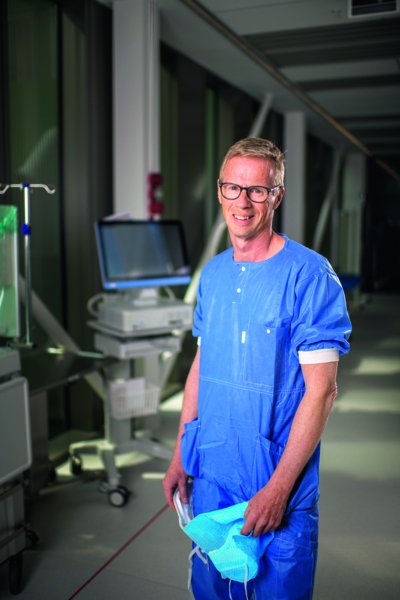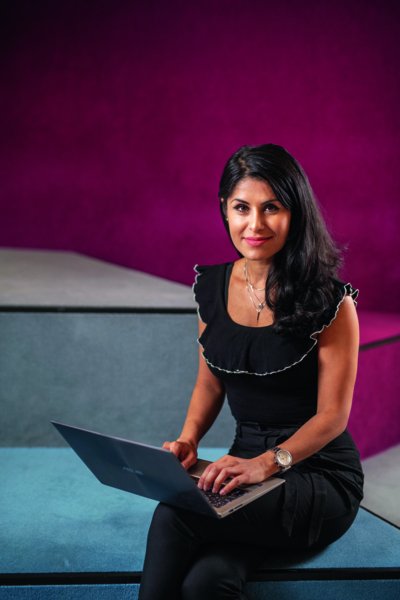Three researchers on new thinking
A product, a service or a smart technology – innovation can come in many shapes. Meet three researchers from Karolinska Institutet who have gone from idea to action.
As told to: Maja Lundbäck, first published in Swedish in the magazine Medicinsk Vetenskap No 2/2019.
Photo: Emil Nordin
Name: Johan Lundberg
Innovation: Extroducer, a microcatheter that can reach inaccessible tumours and organs.
Title: Affiliated researcher, Department of Clinical Neuroscience, Karolinska Institutet.

The next step is a human
“When I was a doctoral student, I attempted to transplant cells into the brain using a method where you navigate through the blood vessels. It didn’t work and I could never figure out where the cells went, they sure didn’t end up in the brain. Eventually, we realised that the cells needed certain properties to enable them to interact with the vessels and get out of them. My supervisor Staffan Holmin and I then realised that we had to build a catheter. At first, we tried to do it on our own, but fairly soon we started collaborating with our co-inventor Stefan Jonsson at KTH. Together we developed the “Extroducer”, a microcatheter that can be used, for example, to inject drugs into inaccessible tumours and transplant insulin-producing cells into the pancreas. This invention and its method also became part of my thesis.
Specifically, I am now hoping that this method can be used to treat a form of brain cancer in children called pontine glioma, which has an extremely poor prognosis. We also want to provide a tool for the endocrinologists, in the hope that they will be able to cure type 1 diabetes.
If I had known how difficult it would be to succeed with the Extroducer and its method, perhaps I wouldn’t have started, because we have been at it for 12 years now and it is still not in clinical use. In 2015, a company bought the rights to develop the technology, but my co-inventors and I are still trying to design the process. We started with the front leg of a rat, then we did the same thing in the brain, heart, pancreas and intestines of larger animals such as pigs. Now we are approaching the next step: humans.”
Name: Rikard Wedin
Innovation: PATHFx, decision support for the treatment of patients with bone metastases.
Title: Docent at the Department of Molecular Medicine and Surgery, Karolinska Institutet. Orthopaedic surgeon at Karolinska University Hospital.

Help doctors make the right choice
“Patients with fractures or paralysis due to bone metastases have seven months left to live on average. A fracture caused by cancer rarely heals. And if you have a very short time left, you will not usually benefit from surgery, and it is perhaps better to be at home with your family and receive palliative care. I presented my thesis in the year 2000 on the surgical treatment of bone metastases, and I have long been wanting to tailor the treatment administered to this patient group.
Now I mostly research decision support based on machine learning and patient records together with an American colleague, Jonathan Forsberg. Ten years ago, we started developing a system for decision support that helps doctors to choose a treatment adapted to the patient’s life expectancy.
With the help of machine learning, we have created an algorithm based on eleven variables that all impact survival. Our system, PATHFx, was properly up and running six months ago, and now we have 300 doctors
across the world using it. The doctor inputs information into the computer or phone, and immediately receives a patient-specific survival curve in return. One challenge is that the algorithms must be retrained on a regular basis, as the prognoses change with the emergence of new treatments. For this reason, we have a bone metastases register integrated with PATHFx. We have written a number of scientific articles where we have proven that it is effective. The decision support would be most useful if it was integrated with the patient records, but it has been difficult to make the county councils see the benefit. The project is currently running thanks to research grants. Now we have to start finding external sponsors, but I am not a great salesperson.”
Name: Berkeh Nasri
Innovation: MindMend, an e-health platform for treatment of adults with ADHD.
Title: Researcher affiliated to the Department of Clinical Neuroscience at Karolinska Institutet, psychologist and CEO of MindMend.

It has taken time to develop the platform
“In the beginning, MindMend was a broad e-health platform for different types of illness in working life, but we then started focusing solely on ADHD; our first client changed our minds. The idea of starting something of your own and having a career in the private sector came to my two co-founders and I towards the end of our doctoral studies. Becoming an entrepreneur – wanting to turn your ideas into a product – is sometimes looked down upon within academia. But isn’t it good to use your background to create things that will benefit patients and care providers so that not everything ends up on some research shelf?
Adults with ADHD are being neglected within the psychiatric health service. After being diagnosed, they will be given a drug prescription at best, or nothing at all. Since 50 per cent do not tolerate, do not respond to, or experience insufficient effect from drug treatment, there is a need for supplementary psychological interventions. One problem is that there is a lack of evidence regarding what treatment components are active, and there have been no treatment manuals that attempt to cover the many and complex aspects of ADHD problems in adulthood. As a doctoral student, I developed such a manual, which is based on a combination of cognitive and dialectical behavioural therapy. I have also examined whether the treatment is effective online and whether it is accepted by the patients – the effects seem promising, even if there is room for improvement.
It has taken some time to develop the platform, which caters to care providers. A pilot client has had ten patients try the treatment, and they were generally pleased with it.”
